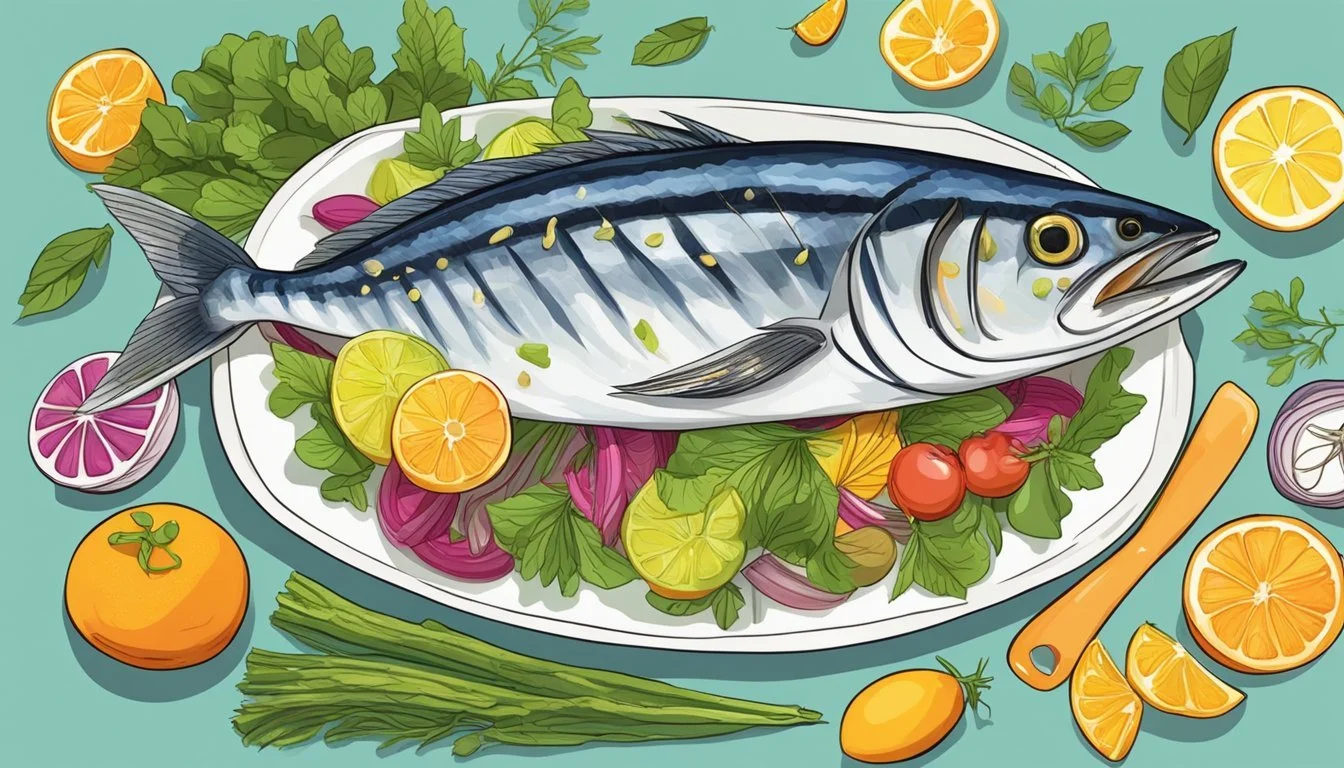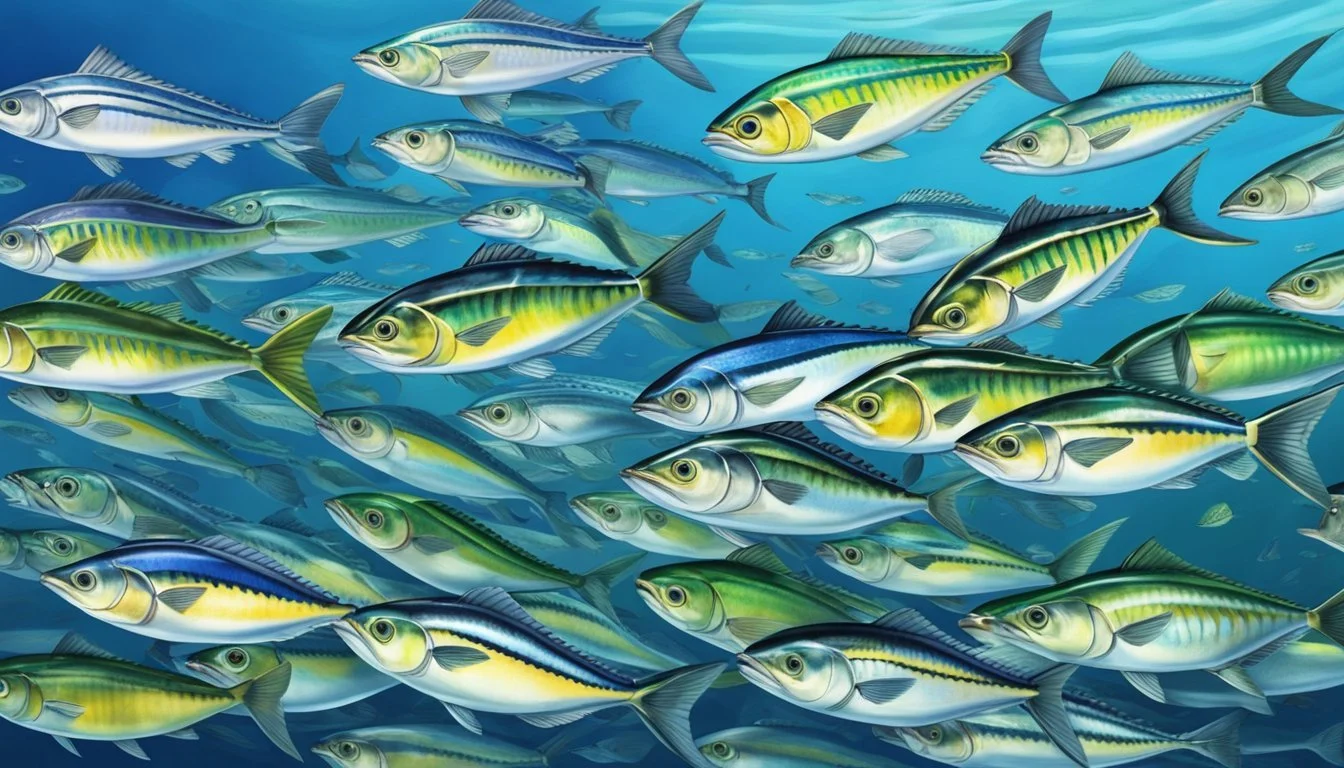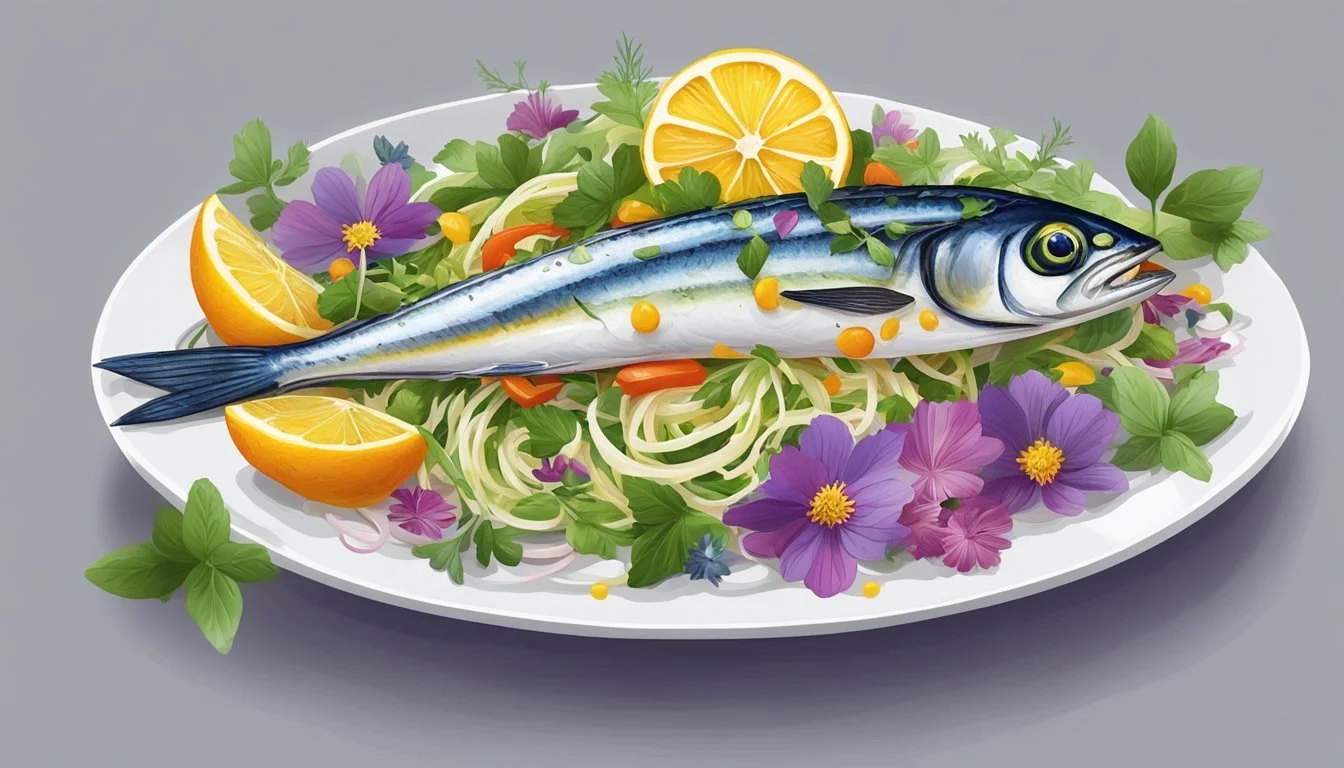How do you eat mackerel?
Your Guide to Enjoying this Tasty Fish
Mackerel is a nutritious and flavorful fish (What wine goes well with fish?) that has earned its place in kitchens around the globe. As an oily fish, it boasts high levels of omega-3 fatty acids, which are essential for cardiovascular health. The robust flavor of mackerel pairs well with a variety of ingredients, making it a versatile component in many dishes. Whether grilled, baked, or canned, mackerel offers a hearty taste and a plethora of health benefits.
In its canned form, mackerel serves as a convenient and shelf-stable protein source. It can be enjoyed straight from the can or incorporated into salads, pastas, and sandwiches. With larger fillets compared to sardines, canned mackerel offers a substantial portion that can easily become the star of a meal. Its preparation ranges from simple to intricate, allowing for culinary creativity, whether one is crafting a quick snack or an elaborate entree.
One of the advantages of mackerel is its ease of preparation. Fresh mackerel fillets can be cooked swiftly in a pan, often only requiring about ten minutes to reach the perfect degree of doneness. Seasoned with just salt and pepper, the fish's natural flavors are allowed to shine. Beyond pan-frying, baking mackerel in the oven is another straightforward method that yields a delicious result. When it comes to this fish, simplicity often leads to the most satisfying dishes, allowing the mackerel's distinct taste to take center stage.
Nutritional Profile of Mackerel
Mackerel stands out as a nutrient-rich fish, packing a significant amount of essential nutrients within its oily flesh. This fish is known for its high content of omega-3 fatty acids, primarily EPA (eicosapentaenoic acid) and DHA (docosahexaenoic acid), which are crucial for heart health, helping to lower blood pressure and cholesterol levels.
Aside from omega-3s, mackerel is also an excellent source of protein, important for muscle repair and immune function. It contains a modest amount of calories while offering a dense nutrient profile, making it a suitable choice for those monitoring their calorie intake. The fish's protein content provides all the essential amino acids, supporting various bodily functions.
In terms of vitamins and minerals, mackerel is particularly rich in vitamin B12, essential for the nervous system and blood cell formation. It also provides other B vitamins like niacin (B3) and vitamin B6, which aid in energy metabolism and enzyme function. The presence of vitamin D supports bone health, while selenium serves as a powerful antioxidant, and iron supports blood health.
Here's a breakdown of some key nutrients found in mackerel:
Fats: Predominantly healthy unsaturated fats, with a lower proportion of saturated fats.
Micronutrients: Contains phosphorus, calcium, magnesium, copper, potassium, and other essential minerals.
Mackerel offers fewer carbohydrates, which makes it a suitable option for low-carb diet plans. Its nutritional spectrum is beneficial for overall health, contributing not just to heart health but also to brain function and the body's enzymatic activities.
Selecting Quality Mackerel
When choosing mackerel, whether canned or fresh, a consumer's priority should be to ascertain its freshness. Mackerel spoils quickly due to its oily nature, thus determining its freshness is crucial. There are several indicators that can guide this process.
For fresh mackerel:
Eyes: They should be bright and clear, not dull or sunken.
Skin: Look for shiny and firm skin with a metallic sheen, which is a clear sign of a fresh fish.
Smell: Fresh mackerel will have a clean, briny scent reminiscent of the ocean. Any strong fishy odor can indicate spoilage.
For canned mackerel:
Expiration date: Always check the packaging for the expiration date to ensure it's within a safe timeframe for consumption.
Can integrity: Ensure there are no dents, rust, or swelling that could point to contamination or spoilage.
Indicators Fresh Mackerel Canned Mackerel Eyes Bright and clear Not applicable Skin Shiny and firm Not applicable Smell Clean, briny scent Should not have a strong, off-putting fishy odor Packaging NA Intact, no dents, rust, or swelling Expiration NA Clearly marked and not lapsed
By vigilantly following these guidelines, consumers can confidently select high-quality mackerel for their meals.
Preparing Mackerel Before Cooking
Proper preparation of mackerel enhances the fish's natural flavors and ensures a delightful eating experience. Prepping involves two main steps: cleaning and filleting, followed by curing or marinating to infuse the mackerel with a range of flavors.
Cleaning and Filleting Mackerel
Before mackerel can be cooked, it is essential to clean and fillet it properly. This process prevents any unintended flavors and makes the fish more appetizing to eat.
Scale the fish: Scrape against the grain of the fish's scales under running water until the skin is smooth.
Gut the mackerel: Make an incision from the anus to the base of the head, remove the innards, and wash the cavity clean.
Remove the head: Cut at an angle from behind the gill towards the belly to remove the head.
Filet the fish: Starting from the tail, run a sharp knife along the backbone, and carefully separate the fillet from the skeleton.
Debone the fillets: Locate any pin bones and use tweezers to gently pull them out.
Note: Throughout the process, a sharp, flexible knife will facilitate cleaner cuts and easier filleting.
Curing and Marinating Mackerel
Curing and marinating not only impart flavors but can also help preserve the fish.
Curing:
Mix equal parts sugar and salt, adding optional aromatic herbs or spices like crushed garlic.
Coat the mackerel fillets thoroughly with the mixture, lay on a tray, cover, and refrigerate for a few hours.
Rinse the cure off with cold water, and pat the fish dry before cooking.
Marinating:
Prepare a marinade of olive oil, lemon juice, salt, and pepper to taste, and other seasonings like minced garlic if desired.
Place mackerel fillets in the marinade, ensuring each piece is well-coated.
Let it sit for at least 20 minutes to absorb the flavors before cooking.
By attending to these preparatory details, the mackerel is readied for a variety of cooking methods, with each step contributing to the fish's final taste and texture.
Cooking Techniques for Mackerel
https://youtu.be/n07MmM8w-YIMackerel is a flavorful fish that can be prepared through various cooking techniques, each bringing out its distinct taste and texture. Whether grilled, baked, or pan-fried, mackerel provides a versatile platform for herbs and seasonings.
Grilling Mackerel
Grilling mackerel is an excellent method to highlight its rich, oily nature. The high heat ensures a crispy skin and a moist interior. To grill mackerel, one should preheat the grill to a high temperature, oil the grates to prevent sticking, and season the fish with salt, pepper, and desired herbs. Typically, mackerel fillets need about three to four minutes per side to cook properly.
Baking Mackerel
Baking is a fuss-free method that lets the fish's natural flavors shine. Preheat the oven to 400°F (200°C), place the mackerel on a lightly oiled baking dish, and season with salt, pepper, and optional herbs like dill or parsley. Baking time can vary from 15 to 20 minutes depending on the size of the fillets or if it's whole.
Pan-Frying Mackerel
Pan-frying mackerel on the stove is quick and yields a delicious, crispy skin. Start by heating a skillet over medium-high heat with a small amount of oil or butter. Season the mackerel with salt and pepper, then place it skin side down in the hot pan. Cook for about five minutes before turning it over to finish cooking for another five minutes. The result is a golden-brown crust surrounding the tender fish. Serve with buttered bread to compliment the mackerel's flavor.
Serving and Pairing Mackerel
With its rich, oily flavor and firm texture, mackerel stands as a versatile fish that pairs delightfully with various accompaniments. When served, mackerel fillets elevate the dish with their robust taste, often enhanced with a drizzle of lemon juice and olive oil.
Accompaniments for Mackerel
Mackerel's strong flavor harmonizes well with a range of sides. Here are some ideal pairings:
Grains: Plain or seasoned rice provides a neutral base that complements mackerel's savory notes.
Vegetables:
Avocado: Its creamy texture pairs smoothly with mackerel's firmness.
Salads: Their freshness balances the richness of mackerel. Incorporating onions and tomatoes can add a zesty twist.
Coleslaw: Offers a crunchy texture for contrast.
Potato Dishes: Both boiled potatoes and creamy potato salad serve as a hearty counterpoint to the mackerel's strong flavors.
Wine Pairing with Mackerel
Selecting the right wine can enhance the dining experience. Here's a brief guide for pairing wines:
White Wines: Light and zesty white wines, such as Sauvignon Blanc or Pinot Grigio, can complement mackerel without overpowering its taste.
Rosé Wines: Their crispness can provide a refreshing contrast to the oily nature of the fish.
Sparkling Wines: A glass of bubbly can cut through the richness of mackerel and add an element of luxury to the meal.
The key is to match the intensity of the fish with the wine, ensuring neither the mackerel nor the beverage dominates the palate.
Canned Mackerel Varieties and Usage
Canned mackerel offers a wealth of possibilities for those looking to diversify their pantry with nutritious, shelf-stable fish options. It's an excellent alternative to more common canned fish like tuna and sardines, providing a unique flavor profile and larger fillet sizes suitable for a variety of dishes.
Choosing Canned Mackerel
When selecting canned mackerel, one should look for:
Origin: High-quality canned mackerel often lists its source, offering a traceability factor favored by conscientious consumers.
Type of Cut: Options include whole fillets or chunks, with whole fillets being ideal for substantial meal components.
Oil or Water-Packed: Mackerel packed in oil may have a richer taste, while water-packed is a lighter option, often preferred for its lower calorie content.
Added Flavors: Varieties with added flavors like mustard, tomato sauce, or herbs can enhance dishes, but plain versions offer more versatility in cooking.
It's important to note that the nutritional content and flavor can be affected by the type of packing liquid and any additional seasonings included with the fish.
Incorporating Canned Mackerel into Meals
Canned mackerel is incredibly versatile in meal preparation. Here's how to make the most of it:
Salads: Flake mackerel over greens for a twist on a traditional tuna salad.
Sandwiches: Combine with ingredients like mayonnaise, onions, and capers (What wine goes well with capers?) for a hearty sandwich filling.
Pasta Dishes: Toss it with cooked pasta, garlic, and cherry tomatoes for a quick Mediterranean-inspired meal.
Charcuterie Boards: Introduce it as a flavorful option alongside other cured meats and cheeses.
By embracing the various uses of canned mackerel, one can create dishes that range from simple and comforting to complex and sophisticated, all while maintaining a healthy diet.
Health Considerations When Eating Mackerel
Mackerel is a nutrient-rich fish that offers significant health benefits, particularly for heart health. It is a great source of omega-3 fatty acids, which are known to reduce blood pressure and lower cholesterol levels, promoting cardiovascular wellness. The American Heart Association recommends the consumption of oily fish like mackerel for its potential to decrease the risk of arrhythmias and atherosclerosis.
Omega-3 Fatty Acids and Heart Health:
Reduce blood pressure: Omega-3s help dilate blood vessels, leading to lower blood pressure.
Lower cholesterol levels: These good fats can decrease triglycerides and balance cholesterol.
However, individuals should be mindful of the mercury content in mackerel. Larger species like king mackerel may contain higher mercury levels, which can be detrimental if consumed in large quantities, especially for pregnant women and young children.
Mercury Considerations:
Species matters: Opt for lower mercury mackerel such as Atlantic mackerel.
Follow guidelines: Heed consumption frequency advice from health authorities.
Consumers should also consider the method of preparation. Eating mackerel in a way that preserves its healthful properties, such as grilling or baking, is recommended. Adding mackerel to a well-balanced diet can assist in maintaining healthy cholesterol levels and support overall body wellness.
Preparation Tips for Health:
Cooking methods: Grill or bake to retain omega-3 content.
Serving suggestions: Pair with vegetables for a balanced meal.
Sustainability and Environmental Impact
The sustainability of mackerel relates to its status as a commonly consumed oily fish, known for being a rich source of Omega-3 fatty acids. Mackerel, including species such as Atlantic mackerel and king mackerel, factors into discussions on sustainable fishing practices. These species are migratory, mostly found in the Atlantic Ocean and, in the case of some species like the king mackerel, in the Gulf of Mexico.
Sustainable fishing practices aim to preserve fish stocks and minimize environmental impacts. However, overfishing has been a significant concern, leading to the fluctuation in mackerel populations. For instance, the Natural Resources Defense Council (NRDC) includes certain types of mackerel on their list of more sustainable seafood choices, provided they are caught using methods that minimize harm to marine habitats and other wildlife.
Atlantic Mackerel: Generally considered a better choice when sourced from well-managed and healthy stocks.
King Mackerel: Advised to be consumed in moderation due to potential mercury content, with sustainability depending on the fishing practices and region.
In terms of environmental impact, sustainable seafood certifications and guides suggest looking for mackerel that is MSC-certified or amber-rated, with an emphasis on supporting fisheries that adhere to quotas and employ methods that reduce bycatch.
Fisheries management organizations strive to assess and adjust fishing allowances to ensure mackerel stocks can replenish, attempting to strike a balance between economic interests and the conservation of natural resources. Consumers can contribute to the effort by opting for mackerel from sustainable sources and staying informed about the environmental status of fish stocks.
Alternative Mackerel Recipes and Fusion Dishes
Mackerel is a versatile fish that lends itself well to a variety of recipes. This section explores how mackerel can be incorporated into world cuisines and transformed with creative twists on traditional dishes.
Mackerel in World Cuisines
Mackerel has a firm place in global gastronomy, with each culture infusing it with regional flavors. In Japan, chub mackerel is often seasoned with soy sauce and ginger, then grilled to perfection. This preparation allows the oily richness of the fish to harmonize with the umami and zing of the seasonings.
Spanish mackerel, aptly named, is a staple in Spanish cuisine, where it's used in tapas such as escabeche. This dish involves marinating the fish in an acidic mixture typically containing vinegar, which imparts a delicate pickle-flavored profile.
Korean-style mackerel, another example, showcases the fish in a spicy marinade with chilli and other seasonings before being cooked. It often accompanies kimchi and rice, offering a balance of bold and fermented flavors.
Creative Twists on Traditional Mackerel Dishes
Chefs are reimagining traditional mackerel recipes with innovative ingredients and methods.
Transforming mackerel into fish cakes is one such variation, where the fish is combined with egg, breadcrumbs, and herbs then pan-fried for a crispy exterior and moist interior.
Infusing mackerel with Italian flavors can also yield delicious results, such as incorporating chunks of mackerel into a robust tomato sauce over pasta, where the fish adds a layer of hearty, oceanic flavour to the dish.
Method Ingredients Cooking Technique Mackerel Fish Cakes Mackerel, Egg, Breadcrumbs, Herbs Pan-frying Pasta with Mackerel Mackerel, Tomato Sauce, Pasta Boiling, Simmering
Cooking mackerel in these alternative ways not only broadens its culinary uses but also makes it accessible to those who might be wary of its distinct taste. Whether through global culinary traditions or innovative recipe adaptations, mackerel's flavor can be suitably tailored to a multitude of palates.
Storage and Preservation of Mackerel
Storing and preserving mackerel appropriately is crucial because it spoils quickly due to its high oil content. Mackerel should be stored at low temperatures, ideally between 32°F (0°C) and 39°F (4°C), to slow down bacterial growth and enzymatic activity. When refrigerated properly, fresh mackerel can maintain its quality for a limited time before consumption.
Refrigeration
Fresh Mackerel: It should be consumed within 1-2 days of purchase.
Smoked Mackerel: Can last between 7-10 days at room temperature and up to 10-18 days when refrigerated.
Freezing
For longer storage, mackerel can be frozen. Whole mackerel, fillets, or smoked mackerel should be wrapped tightly to prevent freezer burn and can be stored frozen for up to 3 months.
Canning
Canned mackerel is shelf-stable and a practical option for extended storage. Once opened, however, it should be transferred to a glass or plastic container and consumed within 3-4 days when stored in the refrigerator.
Salting and Smoking
Traditionally, methods like salting (curing) and smoking were employed:
Salt Cure: Applying sodium aids in removing moisture, extending the fish's shelf life.
Smoking: Both cold and hot smoking techniques preserve and flavor the mackerel.
These methods not only add culinary variety but also effectively increase shelf life when refrigeration is not possible.
Summary Table
Method Storage Condition Expected Shelf Life Refrigeration 32°F (0°C) to 39°F (4°C) 1-2 days (fresh), up to 18 days (smoked) Freezing Below 0°F (-18°C) Up to 3 months Canning Room temperature Until open, then 3-4 days refrigerated Salting/Smoking Varies Extended shelf life
Proper storage and preservation techniques are essential to ensure the safety and quality of mackerel for consumption.
Understanding Mackerel Varieties and Species
Mackerel is a term used to describe a variety of species from the Scombridae family. They are known for their firm texture and rich, oily flesh, which makes them a desirable catch for culinary use. Each mackerel species has distinct characteristics and habitats.
King Mackerel (Scomberomorus cavalla) The king mackerel is a large fish, often weighing more than 20 pounds. It features a streamlined body and can reach up to 170 cm in length. The species is a popular sport fish known for its speed and agility in the western Atlantic.
Spanish Mackerel (Scomberomorus commerson) Another noteworthy variety is the barred Spanish mackerel, an Indo-Pacific fish which can grow quite large, with some specimens reaching up to 100 pounds. They are characterized by their distinctive vertical stripes.
Chub Mackerel (Scomber japonicus) Chub mackerel are smaller, usually weighing between 2 to 4 pounds and measuring 8-13 inches long. They possess large eyes and are recognizable by their cream-colored, forked tail with black outlines.
Atlantic Mackerel (Scomber scombrus): This is a common type found in the Atlantic Ocean. With a blue-green or silver coloration, they thrive in the cool waters of the North Sea and the Mediterranean Sea.
Understanding the various species is important, as the culinary properties differ from one mackerel type to another. Their habitats and behaviors also affect availability and sustainability considerations when sourcing and consuming these fish.
Innovative Serving Ideas for Mackerel
Mackerel's rich flavor and tender texture make it versatile for various culinary experiments. From light snacks to rich salads, inventive uses of spices and accompaniments can transform this fish into a range of delicious dishes.
Mackerel as a Snack
One can enjoy mackerel simply yet delightfully, often requiring minimal preparation. For a healthy and convenient snack:
Lemon-Infused Mackerel Toast: On slices of crusty bread, one can place grilled mackerel seasoned with a pinch of sea salt and lemon zest, then drizzle with olive oil for a zesty treat.
Avocado Mackerel Bites: Pair the mackerel with avocado on a crisp cracker, tapping into the creamy texture of the avocado to complement the mackerel's flavor.
Mackerel in Salads and Appetizers
Mackerel elevates salads and appetizers, contributing its rich taste to light, nutritious starters.
Mackerel and Quinoa Salad: Toss flaked mackerel with cooked quinoa (how long does cooked quinoa last?), diced veggies like cucumbers and tomatoes, and a lemongrass-infused dressing to create a refreshing and flavorsome salad.
Spiced Mackerel Lettuce Wraps: Wrap spiced mackerel fillets in tender lettuce leaves and top with a bright, citrusy slaw to balance the mackerel's oily profile, showcasing how well the fish pairs with different flavors and spices.
Health Benefits of Consuming Mackerel
Mackerel is a nutritious fish that's rich in omega-3 fatty acids, which are essential for heart health and have been shown to lower blood pressure. Each fillet of mackerel provides an abundant supply of these beneficial fats, notably DHA (docosahexaenoic acid), which may reduce inflammation and support cognitive function.
The fish is also an excellent source of selenium, a powerful antioxidant that plays a critical role in maintaining a robust immune system and could help lower the risk of chronic diseases. Regular consumption of mackerel can contribute to lower cholesterol levels, further enhancing cardiovascular health.
Nutritional Highlights of Mackerel:
Omega-3 fatty acids: Supports heart health and reduces inflammation.
Selenium: Essential for immune function and antioxidant protection.
Protein: Provides all essential amino acids for tissue repair and muscle growth.
Incorporating mackerel into one's diet can contribute to meeting daily protein requirements and maintaining overall physical wellbeing. It should be regarded as a beneficial addition to a heart-healthy dietary pattern.
Tips for Buying and Storing Fresh Mackerel
When selecting fresh mackerel, one should look for clear signs of freshness. They should inspect the eyes of the fish, which need to be clear and not cloudy. Clear eyes are a good indicator that the fish is fresh. Additionally, the skin should be shiny and the flesh firm to touch. Any fishy or ammonia-like odors can signal that the mackerel is no longer fresh and should be avoided.
Buying Fresh Mackerel:
Eyes: Should be clear, not cloudy
Skin: Should be shiny and metallic
Smell: Should lack a strong fishy or ammonia-like odor
Texture: Flesh should feel firm
Upon purchasing, one must remember that mackerel spoils quickly due to its high oil content and should be consumed quickly. According to the Natural Resources Defense Council, it's important to store seafood properly to minimize spoilage and waste.
Storing Fresh Mackerel:
Temperature: Store between 32°F (0°C) and 39°F (4°C)
Humidity: Maintain moderate levels to prevent drying out
Container: Use an airtight container for sliced or cooked mackerel
Shelf Life: Ideally consume within 2-3 days when stored in the fridge
Freezing: Can be frozen for up to 3 months
The table below summarizes the key storage parameters:
Storage Location Temperature Shelf Life Notes Fridge 32°F (0°C) - 39°F (4°C) 2-3 days Store in an airtight container Freezer Below 0°F (-18°C) Up to 3 months Freeze in appropriate portions
Consumers should keep in mind that while refrigeration can extend the shelf life of mackerel, it remains a perishable item and should not be considered shelf-stable. It's crucial to follow these guidelines to ensure the benefits of this nutritious fish are enjoyed at their peak of freshness and flavor.
Mackerel Preparation Safety and Hygiene
When preparing mackerel, it's important to observe safety and hygiene practices due to its tendency to spoil quickly. Fresh mackerel should exhibit a shiny appearance, firm flesh, and a clean ocean scent. Any sign of dull skin or a strong, unpleasant odor indicates spoilage, and such fish should not be consumed.
To ensure optimal safety:
Storage: Mackerel must be stored immediately at cold temperatures. Use ice or a refrigerator to maintain a temperature below 40°F (4°C), as this slows bacterial growth.
Handling: Wash hands thoroughly with soap and water before and after handling mackerel to prevent cross-contamination.
Here is a checklist for safe mackerel preparation:
Task Description Inspection Check for freshness: clear eyes and shiny skin. Cleaning Use clean utensils and surfaces to prevent contamination. Rinsing Always rinse mackerel under cold, running water. Cooking Mackerel should be cooked to an internal temperature of at least 145°F (63°C). Consumption Eat cooked mackerel promptly; refrigerate leftovers within two hours.
Mackerel contains sodium, which serves as a natural preservative to a degree. However, this does not eliminate the need for proper refrigeration both before and after cooking.
Additionally, when handling mackerel or any fish, one must avoid cross-contamination with ready-to-eat foods by using separate cutting boards and utensils or sanitizing them between uses. It's essential to integrate these practices to enjoy mackerel safely.








